英语教学法重点
- 格式:doc
- 大小:274.83 KB
- 文档页数:94
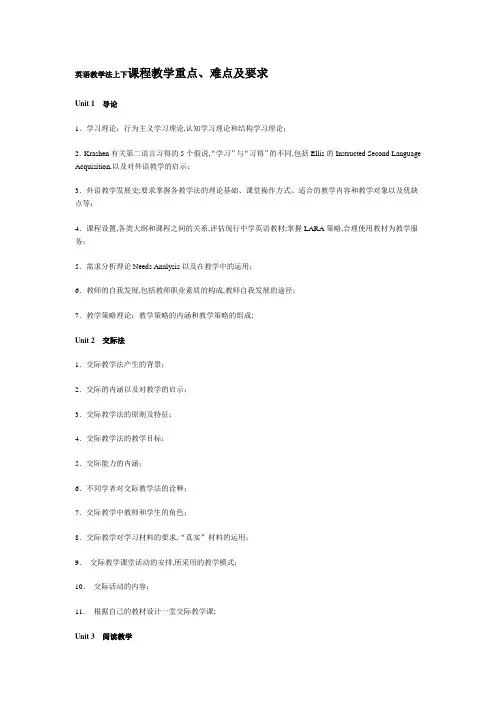
英语教学法上下课程教学重点、难点及要求Unit 1 导论1.学习理论:行为主义学习理论,认知学习理论和结构学习理论;2.Krashen有关第二语言习得的5个假说,“学习”与“习得”的不同,包括Ellis的Instructed Second Language Acquisition,以及对外语教学的启示;3.外语教学发展史;要求掌握各教学法的理论基础、课堂操作方式、适合的教学内容和教学对象以及优缺点等;4.课程设置,各类大纲和课程之间的关系,评估现行中学英语教材;掌握LARA策略,合理使用教材为教学服务;5.需求分析理论Needs Analysis以及在教学中的运用;6.教师的自我发展,包括教师职业素质的构成,教师自我发展的途径;7.教学策略理论:教学策略的内涵和教学策略的组成;Unit 2 交际法1.交际教学法产生的背景;2.交际的内涵以及对教学的启示;3.交际教学法的原则及特征;4.交际教学法的教学目标;5.交际能力的内涵;6.不同学者对交际教学法的诠释;7.交际教学中教师和学生的角色;8.交际教学对学习材料的要求,“真实”材料的运用;9.交际教学课堂活动的安排,所采用的教学模式;10.交际活动的内容;11.根据自己的教材设计一堂交际教学课;Unit 3 阅读教学1.“阅读”的内涵,掌握有关阅读的几种观点,包括心理猜测理论和互动阅读理论;2.影响有效/流畅阅读的因素;3.有关良好阅读者的研究;4.阅读教学中学生动机的激发;5.阅读教学模式:top-down approach, bottom-up approach 和interactive approach;各模式的理论依据,课堂操作方式,优缺点等;6.阅读的层次,包括read the lines, read between the lines 和read beyond the lines plain sense reading, deductive reading, projective reading;能举例说明各阅读层次,如何开展教学活动培养三层阅读理解能力;7.阅读过程:pre-reading, while-reading 和post-reading;各阶段活动如何开展,运用的是什么教学模式,可开展哪些活动;要求能够就具体材料设计出各阅读阶段的教学活动,写成教案,进而在班内演示,能充分讨论具体材料的各种可能性操作;8.阅读策略的培养,包括the Strategic Teaching Mode, the Cognitive Academic Language Learning Approach 和the Reciprocal Teaching Approach;Unit 4 听力教学1.现实听与课堂听的不同,以及对外语教学的启示;2.影响听力的因素;3.听力教学中学生动机的激发;4.听力教学模式:bottom-up approach,top-down approach 和interactive approach;掌握各类模式的操作方式;5.听力教学的内容,如何教授和训练这些内容;6.听力策略和听力教学策略有哪些;7.听力材料的选择;8.听力教学活动的安排;9.听力教学的过程:pre-reading, while-reading 和post-reading,各阶段的教学目的,操作方式和可采用的活动;要求根据具体学习材料写出每一阶段的教案并在班内演示,充分讨论各种操作方式的适用性,有效性等;Unit 5 口语教学1.现实生活中的口头交际特点以及对外语教学的启示;2.会话技巧及其培养;3.口语课的教学内容;4.口语课的教学原则;5.口语课的课堂教学模式,包括3P模式和task-based approach;6.口语课的课堂教学程序:presentation, practice 和production;掌握展示的内容、技巧方法和有效的教学活动;要求能根据具体的学习材料设计各阶段的教案;英语教学法下Unit 6 写作教学1. “good writing”的6大特点;2. 写作教学的原则;3. 写作教学的模式:结果定向product-oriented approach,内容定向content-oriented approach,过程定向process-oriented approach和交际定向communication-oriented approach;4. 写作的基本要求;5. 过程定向写作模式的写作教学过程:pre-writing, drafting, revising and editing, 和second drafting;6. 写作与其它活动的结合;Unit 7 语法教学1.显性语法教学和隐性语法教学;2、语法教学的原则动机原则,效率原则,变化原则,全面原则,程序原则,交际原则和手段原则是什么,在教学中如何体现;3、语法教学的模式:演绎教学模式deductive approach、归纳教学模式inductive approach和基于任务的教学模式task-based approach ;4、语法教学的程序:presentation,practice ,production和evaluation;5、阅读和听说课中的语法教学;Unit 8 词汇教学1.词汇教学的内容意义,语法,信息和运用;2、单词的记忆方法以及对教学的启示;3、词汇的选择,即教学中词汇选择的标准;4、词汇教学的过程教学模式:“展示”“运用”和“测评”;5、词汇学习的策略和词汇记忆技巧;6、词汇教学中学生学习动机的激发;7、要求能根据具体语言材料撰写词汇教学教案,设计出词汇教学的活动;Unit 9 备课1.“lesson”所包含的内容至少5部分;2、影响“教案设计”的因素物理因素,人文因素和大纲因素;3、教案设计中应考虑的因素至少8条;4、“教案”的组成部分;5、教案设计中对教材的处理;6、教案的两种格式:图表式和文字叙述式;7、教案的语言要求;8、将本单元教案的撰写与听、说、阅读、写作等具体课型联系起来,要求根据具体的课程材料写出教案;Unit 10 and Unit 11 课堂管理上下1、影响课堂组织的因素;2、课堂组织的内容;3、课堂组织中教师的角色;4、课堂组织中课堂交互模式;5、教师指令给予的原则;6、课堂教学中教师如何“纠错”;7、如何创造舒适的学习环境及如何激发学生的动机;;8、课堂教学中的提问在课堂组织中的运用,提问的策略;9、如何处理不守纪律的学生及学生之间的不平衡;10、应能举出课堂组织的各种实例,综合各个学生的意见,讨论处理方式的得体性,挖掘其对语言学习,语言教学,以及教育和心理学知识的运用;11、如何在教案中展示课堂组织的方式;Unit 12 测试1.测试类型;2.测试设计的基本原则;3.设计阅读、词汇、语法、听力、写作等各项能力的测试;4.阶段测试与教学的关系;5.学习进度情况测试;英语教学法2样题Section I. Basic Theories and Principles 30 pointsDirections: Choose the best answer from . or C for each question. Write your answer on the Answer Sheet. 1.What kind of cohesive devices is used to link sentences through signaling relationships between sentences by means of anaphora or back referenceA. Cohesive devices that indicate meaning relationships between or within sentences, such as apart from, in order to, since, however, not only, and but also.B. Grammatical devices that establish links to from the cohesion of a text, such as it, this, the, here, that, and so on.C. Lexical devices that use the repetition of key words or synonymous words to link sentences together.2. What will a good writer usually do in the pre-writing stage of the writing processA. Make decisions on the purpose, the audience, the contents, and the outline of the writing.B. Concentrate on getting the content right first and leave the details like correcting spelling, punctuation, and grammar until later.C. Develop a revising checklist to pinpoint the weaknesses of his/her writing and focus on the flaws likely to appear in their drafts.3. Writing exercises like completion, reproduction, compression, and transformation are mainly the type of exercises used in which writing tasksA. Controlled writing.B. Guided writing.C. Free writing.4.Which type of grammar tends to teach you how the grammar is used by the people rather than how it should be usedA. Descriptive grammar.B. Prescriptive grammar.C. Traditional grammar.5. When the students are given the structure in an authentic or near authentic context and are asked to work out the rule for themselves, what kind of method their teacher is usingA. Deductive grammar teaching.B. Inductive grammar teaching.C. Traditional grammar teaching.6. In which stage of the Presentation-Practice-Production approach will students have the chance to use the language freely and incorporate it into their existing languageA. Presentation Stage.B. Practice Stage.C. Production Stage.7. How can we help students to memorize a new word more effectivelyA. Put the new word in a context, relate it to known words, and use illustrations.B. Pre-teach the new word of a text, pronounce it correctly, and group it.C. Put the new word in a list of unconnected words with illustrations.8. Which of the following techniques can best present the word “pollution”A. Show or draw a picture.B. Give a definition or an example.C. Demonstrate the meaning by acting or miming.9. Whether two words go together with each other or not is an issue of whatA. Connotation.B. Register.C. Collocation.10. Among the following factors that may affect a lesson plan, which one includes classroom sizeA. Human factors.B. Physical conditions.C. Syllabus and testing.11. What are the most important parts of a lesson planA. Textbooks and classroom aids.B. Anticipation of problems and flexibility in dealing with them.C. Objectives of the lesson and procedure to achieve them.12. Why do we need to design tasks to supplement the textbookA. Textbooks usually are not well written.B. Textbooks need adaptations to fit the needs of their target students.C. Textbooks only cover a limited amount of language skills.13. Among the five subcategories of classroom management, that is people, language, environment, organization and tools, which of the following elements can be classified under environmentA. Textbook, exercise book, teacher’s book, and blackboard.B. Interaction between teacher and students.C. Arrangement of desks and chairs.14. What role does a teacher take to create an environment in which learning can take placeA. Instructor.B. Manager.C. Assessor.15. Whole class teaching, pair work, group work, and games are activities under which subcategory of classroommanagementA. People.B. Environment.C. Organization.Section II: Problem Solving 30 pointsDirections: Below are five situations in the classroom. Each has a problem. First, identify the problem. Second, provide your solution according to the communicative language teaching principles. You should elaborate on the problems and solutions properly. Write your answer on the Answer Sheet.16. In a writing class, the teacher asks the students to write an article about their hometown. To help the students, the teacher also provides a well-written article about hometown by a famous writer as a sample. Students are instructed to follow the style and the organization of ideas of the sample article.17. In a grammar class, the teacher teaches the use of “some”and “any”in the following way:A. Explains the rules of their usage.B. Provides some examples to illustrate the usage of the two words.C. Ask the students to do pattern dills.D. Ask the students to apply the rules to given situations.18. When teaching a new reading passage, the teacher writes all the new words on the blackboard and asks the students to look them in dictionaries. Then the teacher explains the meaning of these new words in simple English, usually by providing some examples of their usage. Sometimes, the teacher may provide the Chinese versions for these words. After dealing with the vocabulary, the teacher will then shift their focus to the reading passage.19. When preparing a lesson, some teachers just rely on the teacher’s book. Before teaching a lesson, they will just look up the new words in the dictionary and copy paraphrases from the teacher’s book onto the student’s book. In class, they will just follow the instructions provided by the teacher’s book.20. This is a traditional classroom. The student’s desks are arranged neatly in rows and columns, while the teacher’s desk is placed in the front the classroom on a platform. The teacher comes into the classroom. All students stand up to greet the teacher and the teacher greets back. Then the teacher starts to talk and the students start to take notes. From time to time, the teacher will ask some questions to the whole class, and those students who know the answers will respond. At other time, the teacher will point at an individual student and asks a question. The teacher also asks the students to do some readings or exercises quietly in class. As the students finish their job, the teacher collects their work and tells them that they will get feedback over the next week.Section III: Mini-lesson PlanDirections: Read the two text below and complete the teaching plans. Write your answer on the Answer Sheet. 21. Please design a writing activity for a writing class based on the following instruction:Study the two texts, which are based on information given in the table. Then write similar texts of your own, to form part of a letter telling someone how to get to a place.Destination Alternatives1 2 Time for1 2AirportSports groundSupermarketCinemaHospitalRailway station Coach taxiTube busTaxi busOn foot taxiBus on footTaxi bus1/2 hour 20 mins10 mins 20 mins5 mins 10 mins1/2 hour 5 minsUse nay suitable period of timeText 1You can go to the airport either by coach or by taxi. If you go by coach, it takes at least half an hour. By taxi, on the other hand, it takes only ten minutes. For that reason, I suggest the second possibility.Text 2There are two ways of getting to the sports ground, either by tube or by bus. By tube it only takes ten minutes, while if you go by bus, on the other hand, it may take you over twenty minutes. My advice to you then, it to go by tube.Type of the activity . brainstorming, information-gap, role-play, problem-solving, etc.Objectives of the activityClassroom organization of the activityTeacher’s rolesStudents’rolesTeacher working timeStudent working timeTeaching aidsPredicated problemsSolutionsProcedures 123422. You are going to teach some vocabulary about temperature. Please design a vocabulary activity based on the following instruction:Look at the box below and try to find out the meaning of each word in a dictionary. Then arrange the words to show their differences in the degree of temperature. Finally, try to make a sentence using each of the wordsFreezing cold chilly cool mild warm hotType of the activity . using word field, answer questions, information-gap, role-play, etc.Objectives of the activityClassroom organization of the activityTeacher’s rolesStudents’rolesTeacher working timeStudent working timeTeaching aidsPredicated problemsSolutionsProcedures 1234英语教学法2样题参考答案Section I. Basic Theories and Principles 30 points1. B 4. A 5. B6. C7. A8. B9. C 10. B11. C 12. B 13. C 14. B 15. CSection II: Problem Solving 30 points16. Problem: The teacher’s instruction to the students is too general and it may leave the students with too much room to choose from. There is no help provided for the students to develop a sense of purpose and a sense of audience. Without a sense of purpose and audience, the students may either feel confused by all possible things that could be included in the writing, or just follow the contents covered in the sample article.Solution: The teacher could first narrow down the topic by providing a situation for the students, such as writing a tour guide for their hometown. Then, help the students to work out possible contents that could be included in the writing, such as location, population, resources for tourism, places of interests, etc. The teacher could also help the students to decide the writing style based on their writing purpose and targeted audience.17. Problem: The teacher teaches grammar in a deductive way. This approach is usually mechanical and dull. The students learn the rules passively with little involvement in the process of working them out. Since rules are sometimes too restrictive, there are lots of exceptions that may confuse the students. This method is usually more concerned with form than use. If students meet the new structure in isolated sentences, they may not get a feel for when and how to use the structure. They are very likely to go on using in incorrectly.Solution: Bring in the inductive grammar teaching approach. By combining the two ways of teaching grammar together, the teacher can achieve a much better result than using either way exclusively. The teacher could first give the students a context and ask them to work out the rules. After collecting the students’suggestions, the teacher could then tell them the existing rules and explain exceptions to the rules. This way, the students will be actively involved in the thinking process and may understand the rules better. They will also be aware of the factthat grammar rules are worked out by people observing the use of language, so they may change as people’s use of language may change.18. Problem: The students taught in this way are mainly receiving passive knowledge from the teacher. They merely learn to understand these vocabularies, rather than how to use them. The new words are not taught from a context, and there is no practice of using them in an authentic or a near authentic situation. This students will not learn these new words in an efficient way.Solution: The students need to learn passive knowledge and active knowledge at the same time. The teacher could use various means to help the students to understand the vocabulary. For some, they can use illustrations, for some, they can use definitions, and for others, they can guess from the context. The teacher could also use different ways to help the students to use the new words. Exercises like information gap, crosswords, quiz, or recording new words all can help the students to learn vocabulary in a more efficient way.19. Problem: Though the teacher’s book may provide very good references and guidance for the teacher, it is not enough. The textbooks we are using usually are not written just for our students. For different students, they have different needs. We need to adapt the textbook to meet the need of our students. Other factors like the physical conditions, our syllabus and system of testing may also affect our planning for a lesson. If we failed to consider all the factors that may affect our teaching, we will not achieve a good result in our teaching.Solution: A lesson plan is very important in the success of teaching. For whatever lesson we are going to teach, we need to have a good lesson plan. First, we need to define the objectives of the lesson plan. That is what we hope to achieve. Then, we need to decide the classroom aids required, such as blackboard, white board, overhead projector, audio-visual facilities, etc. Next, we need to plan the procedure of the lesson, like what will be done, when, by whom, etc. We also need to have a contingency plan in case something unexpected may disrupt the plan. Last, we need to have a checklist to assess our implementation of the plan to see if everything is as planned and what need to be improved.20. Problem: This class has no classroom management at all. The teacher plays a simple role as an instructor and controls every activity of the students. Desks are arranged in a teacher centered way. There is very little students’involvement in the teaching process, and no pair work or group work at all. And we see no effort of using the teaching tools to facilitate the teaching environment. There seems no natural communication between the teacher and the students.Solution: The purpose of classroom management is to create a positive learning environment in which the students will show a willingness to achieve the targets we have set. A good environment needs people’s effort as well as good physical environment. A teacher should play the role of a helper rather than a controller. The desks in the classroom should be arranged to show learner-conteredness. The teacher should communicate with the students in a polite way and show great care and encouragement towards the students. The teacher may also adapt the textbook and use audio-visual aids to make the lesson lively and interesting.Section III: Mini-lesson PlanDirections: Read the two text below and complete the teaching plans. Write your answer on the Answer Sheet.Section III: Mini-lesson Plan 40 pointsType of the activity . multiple-choice questions, short-answer questions, information-gap, role-play, problem-solving, etc. 1 pointObjectives of the activity 2 pointClassroom organization of the activity 1 pointTeacher’s roles 1 pointStudents’roles 1 pointTeacher working time 1 pointStudent working time 1 pointTeaching aids 1 pointPredicated problems 1 pointSolutions 1 pointProcedures 1 2 point2 2 point3 2 point4 2 point21. 供参考Type of the activity . brainstorming, information-gap, role-play, problem-solving, etc. Reading sample texts, brainstormingObjectives of the activity 1. Generate ideas based on given information;2. Learning to organize ideas in a written text from general information to detailed information, suggestions or advice provided and reasons for that, etc.Classroom organization of the activity Pair or group workTeacher’s roles Instructor, organizer, facilitatorStudents’roles Active participant, helping each otherTeacher working time 5-10 minsStudent working time 10-15 minsTeaching aids Some pictures of the destination being listed;Some cardboards indicating means of transportation and estimated time for each alternativePredicated problems Students may raise more authentic alternatives and estimated time for writing suggestions and advice.Solutions Tell the students that the information provided are just based on common knowledge and are mainly served as guidance for them.Tell the students that they are encouraged to use more authentic situations to write their own texts.Procedures 1 Help students to understand the information in the text and the purpose of writing.2 Summarize the organization of the ideas for the writing of suggestions and advice.3 Use teaching aids such as pictures of destinations, cardboards with means of transportation and time for each alternative to help the students prepare for their writing. The teacher may hold a picture of destination and invite students to pick the cardboard of alternatives and add suitable time for it. The students may pick several means of transport and explain the advantages and disadvantages of using them.4 Ask students to work out each one’s organization of ideas in pairs or groups. Make the students aware that the text usually begins with a general introduction, then followed by detailed information for each alternative, and last with a suggestion or advice supported with reasons.22. 供参考Type of the activity . using word field, answer questions, information-gap, role-play, etc. Using word fields, sentence-makingObjectives of the activity 1. Understand the meaning of temperature-related words2. Distinguish the differences in degree of these temperature-related words3. Use these words competentlyClassroom organization of the activity Pair work or group workTeacher’s roles Instructor, organizer, facilitatorStudents’roles Active participantHelping each otherTeacher working time 5-10 minsStudent working time 20-25 minsTeaching aids Blackboard illustration of vocabulary steps and cardboards with one word on each of them Predicated problems Students may tend to use Chinese in vocabulary exercise.Solutions Tell the students try to avoid using Chinese as much as possible while doing vocabulary exercise. Procedures 1 Ask the students to work out the meaning of these words by looking them up in a dictionary.2 Draw a series of steps on the blackboard. Write “cool”on a middle step. Ask the students to work in groups to decide words on the other steps that are colder or warmer than the word “cool”.3 Invite 7 students to pick up a word each. Then instruct them to line up according the degree of temperature of the words they are holding. The teacher may invite several groups of students to do so or may shift order from left or right to from right to left. The teacher should give the correct order in the end.4 Ask the students to work in pairs to practice use of these words. One may produce a cardboard, and the other try to make a sentence using this word. Then the two shift turns until they finish practicing all the words.。
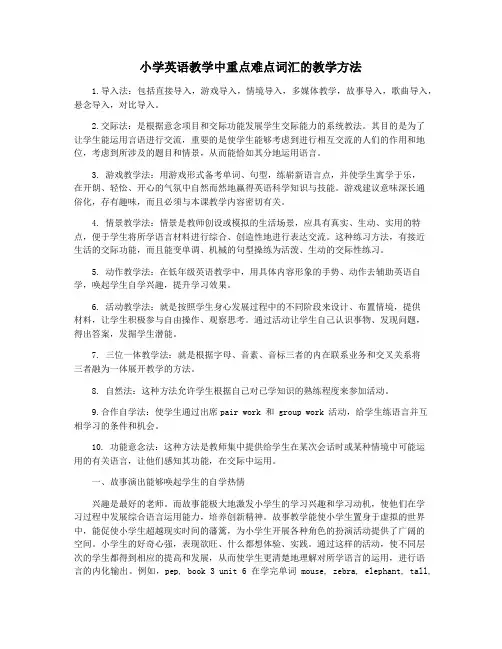
小学英语教学中重点难点词汇的教学方法1.导入法:包括直接导入,游戏导入,情境导入,多媒体教学,故事导入,歌曲导入,悬念导入,对比导入。
2.交际法:是根据意念项目和交际功能发展学生交际能力的系统教法。
其目的是为了让学生能运用言语进行交流,重要的是使学生能够考虑到进行相互交流的人们的作用和地位,考虑到所涉及的题目和情景,从而能恰如其分地运用语言。
3. 游戏教学法:用游戏形式备考单词、句型,练崭新语言点,并使学生寓学于乐,在开朗、轻忪、开心的气氛中自然而然地赢得英语科学知识与技能。
游戏建议意味深长通俗化,存有趣味,而且必须与本课教学内容密切有关。
4. 情景教学法:情景是教师创设或模拟的生活场景,应具有真实、生动、实用的特点,便于学生将所学语言材料进行综合、创造性地进行表达交流。
这种练习方法,有接近生活的交际功能,而且能变单调、机械的句型操练为活泼、生动的交际性练习。
5. 动作教学法:在低年级英语教学中,用具体内容形象的手势、动作去辅助英语自学,唤起学生自学兴趣,提升学习效果。
6. 活动教学法:就是按照学生身心发展过程中的不同阶段来设计、布置情境,提供材料,让学生积极参与自由操作、观察思考。
通过活动让学生自己认识事物、发现问题,得出答案,发掘学生潜能。
7. 三位一体教学法:就是根据字母、音素、音标三者的内在联系业务和交叉关系将三者融为一体展开教学的方法。
8. 自然法:这种方法允许学生根据自己对已学知识的熟练程度来参加活动。
9.合作自学法:使学生通过出席pair work 和 group work 活动,给学生练语言并互相学习的条件和机会。
10. 功能意念法:这种方法是教师集中提供给学生在某次会话时或某种情境中可能运用的有关语言,让他们感知其功能,在交际中运用。
一、故事演出能够唤起学生的自学热情兴趣是最好的老师。
而故事能极大地激发小学生的学习兴趣和学习动机,使他们在学习过程中发展综合语言运用能力,培养创新精神。
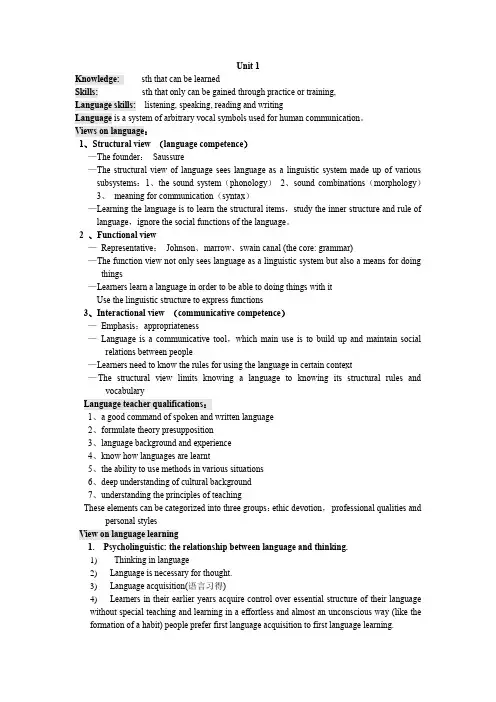
Unit 1Knowledge:sth that can be learnedSkills: sth that only can be gained through practice or training,Language skills:listening, speaking, reading and writingLanguage is a system of arbitrary vocal symbols used for human communication。
Views on language:1、Structural view (language competence)—The founder:Saussure—The structural view of language sees language as a linguistic system made up of various subsystems:1、the sound system(phonology)2、sound combinations(morphology)3、meaning for communication(syntax)—Learning the language is to learn the structural items,study the inner structure and rule of language,ignore the social functions of the language。
2 、Functional view—Representative:Johnson、marrow、swain canal (the core: grammar)—The function view not only sees language as a linguistic system but also a means for doing things—Learners learn a language in order to be able to doing things with itUse the linguistic structure to express functions3、Interactional view (communicative competence)—Emphasis:appropriateness—Language is a communicative tool,which main use is to build up and maintain social relations between people—Learners need to know the rules for using the language in certain context—The structural view limits knowing a language to knowing its structural rules and vocabularyLanguage teacher qualifications:1、a good command of spoken and written language2、formulate theory presupposition3、language background and experience4、know how languages are learnt5、the ability to use methods in various situations6、deep understanding of cultural background7、understanding the principles of teachingThese elements can be categorized into three groups:ethic devotion,professional qualities and personal stylesView on language learning1. Psycholinguistic: the relationship between language and thinking.1)Thinking in language2)Language is necessary for thought.3)Language acquisition(语言习得)4)Learners in their earlier years acquire control over essential structure of their languagewithout special teaching and learning in a effortless and almost an unconscious way (like the formation of a habit) people prefer first language acquisition to first language learning.2.Cognitive theory: the rule for people to aware to cognize sth.Cognitive processes:Process: input----absorb----outputLanguage learning is not just stimulate-reflection, but the using of our subjective capabilities, the using of our cognitive ability to think the language and studying it actively.3. Constructivist theory: learning is a process of meaning construction based on learner’s own knowledge and experience.S ----------AT------------R(刺激) (反应)Stimulus: assimilatio n ①and accommodatio n②①把外部知识纳入自身②纳入自身后也不相符,就要对原有知识进行改变,也就是一种原有知道和外部知识保持联系的创新的过程。
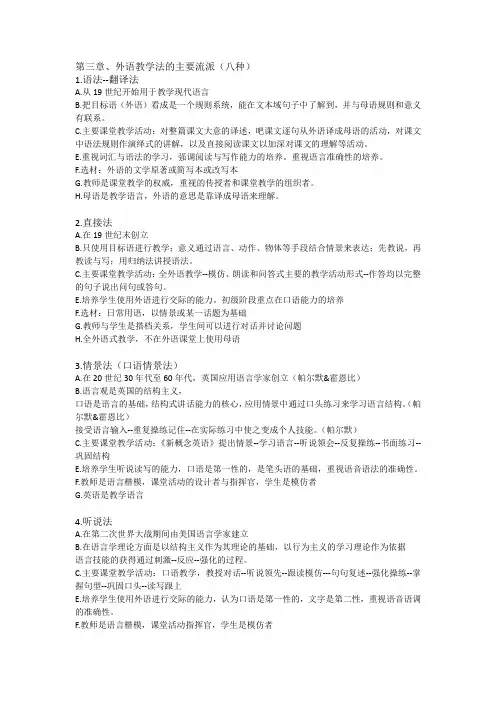
第三章、外语教学法的主要流派(八种)1.语法--翻译法A.从19世纪开始用于教学现代语言B.把目标语(外语)看成是一个规则系统,能在文本域句子中了解到,并与母语规则和意义有联系。
C.主要课堂教学活动:对整篇课文大意的译述,吧课文逐句从外语译成母语的活动,对课文中语法规则作演绎式的讲解,以及直接阅读课文以加深对课文的理解等活动。
E.重视词汇与语法的学习,强调阅读与写作能力的培养。
重视语言准确性的培养。
F.选材:外语的文学原著或简写本或改写本G.教师是课堂教学的权威,重视的传授者和课堂教学的组织者。
H.母语是教学语言,外语的意思是靠译成母语来理解。
2.直接法A.在19世纪末创立B.只使用目标语进行教学;意义通过语言、动作、物体等手段结合情景来表达;先教说,再教读与写;用归纳法讲授语法。
C.主要课堂教学活动:全外语教学--模仿、朗读和问答式主要的教学活动形式--作答均以完整的句子说出问句或答句。
E.培养学生使用外语进行交际的能力。
初级阶段重点在口语能力的培养F.选材:日常用语,以情景或某一话题为基础G.教师与学生是搭档关系,学生间可以进行对话并讨论问题H.全外语式教学,不在外语课堂上使用母语3.情景法(口语情景法)A.在20世纪30年代至60年代,英国应用语言学家创立(帕尔默&霍恩比)B.语言观是英国的结构主义,口语是语言的基础,结构式讲话能力的核心,应用情景中通过口头练习来学习语言结构。
(帕尔默&霍恩比)接受语言输入--重复操练记住--在实际练习中使之变成个人技能。
(帕尔默)C.主要课堂教学活动:《新概念英语》提出情景--学习语言--听说领会--反复操练--书面练习--巩固结构E.培养学生听说读写的能力,口语是第一性的,是笔头语的基础,重视语音语法的准确性。
F.教师是语言楷模,课堂活动的设计者与指挥官,学生是模仿者G.英语是教学语言4.听说法A.在第二次世界大战期间由美国语言学家建立B.在语言学理论方面是以结构主义作为其理论的基础,以行为主义的学习理论作为依据语言技能的获得通过刺激--反应--强化的过程。
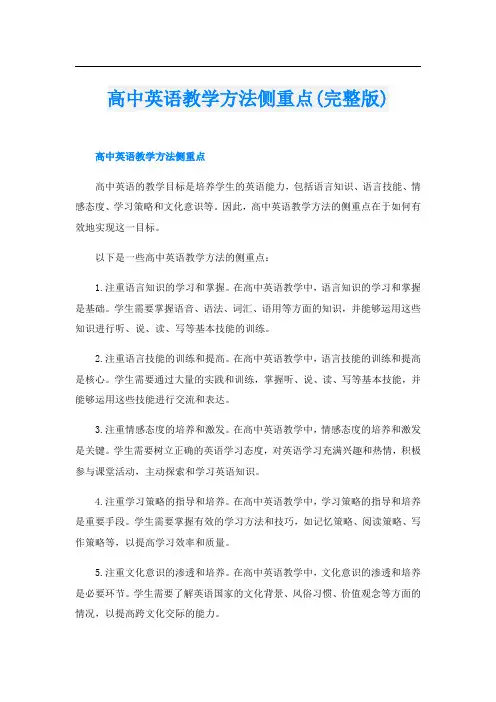
高中英语教学方法侧重点(完整版)高中英语教学方法侧重点高中英语的教学目标是培养学生的英语能力,包括语言知识、语言技能、情感态度、学习策略和文化意识等。
因此,高中英语教学方法的侧重点在于如何有效地实现这一目标。
以下是一些高中英语教学方法的侧重点:1.注重语言知识的学习和掌握。
在高中英语教学中,语言知识的学习和掌握是基础。
学生需要掌握语音、语法、词汇、语用等方面的知识,并能够运用这些知识进行听、说、读、写等基本技能的训练。
2.注重语言技能的训练和提高。
在高中英语教学中,语言技能的训练和提高是核心。
学生需要通过大量的实践和训练,掌握听、说、读、写等基本技能,并能够运用这些技能进行交流和表达。
3.注重情感态度的培养和激发。
在高中英语教学中,情感态度的培养和激发是关键。
学生需要树立正确的英语学习态度,对英语学习充满兴趣和热情,积极参与课堂活动,主动探索和学习英语知识。
4.注重学习策略的指导和培养。
在高中英语教学中,学习策略的指导和培养是重要手段。
学生需要掌握有效的学习方法和技巧,如记忆策略、阅读策略、写作策略等,以提高学习效率和质量。
5.注重文化意识的渗透和培养。
在高中英语教学中,文化意识的渗透和培养是必要环节。
学生需要了解英语国家的文化背景、风俗习惯、价值观念等方面的情况,以提高跨文化交际的能力。
总之,高中英语教学需要注重学生的全面发展,培养学生的综合素养,为学生的未来发展打下坚实的基础。
高中英语具体教学方法高中英语教学应该注重以下几个方面:1.语言教学的全面性:在课堂教学中,除了听说读写四种技能外,还要注重文化素养和语言技能的训练,即涉及英语国家的文化、风俗习惯、社会意识、价值观念和宗教信仰等。
同时,教师要引导学生在听说读写的过程中,对所学内容进行深入思考,并与其他同学、教师进行讨论,以培养他们的综合语言素质。
2.语言教学的启发性:在高中英语教学中,教师要避免仅仅关注语言形式的教学,更要注重语言内容的教授。
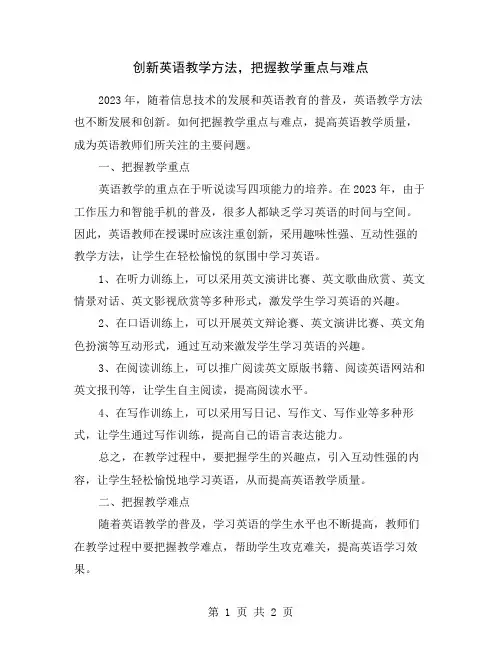
创新英语教学方法,把握教学重点与难点2023年,随着信息技术的发展和英语教育的普及,英语教学方法也不断发展和创新。
如何把握教学重点与难点,提高英语教学质量,成为英语教师们所关注的主要问题。
一、把握教学重点英语教学的重点在于听说读写四项能力的培养。
在2023年,由于工作压力和智能手机的普及,很多人都缺乏学习英语的时间与空间。
因此,英语教师在授课时应该注重创新,采用趣味性强、互动性强的教学方法,让学生在轻松愉悦的氛围中学习英语。
1、在听力训练上,可以采用英文演讲比赛、英文歌曲欣赏、英文情景对话、英文影视欣赏等多种形式,激发学生学习英语的兴趣。
2、在口语训练上,可以开展英文辩论赛、英文演讲比赛、英文角色扮演等互动形式,通过互动来激发学生学习英语的兴趣。
3、在阅读训练上,可以推广阅读英文原版书籍、阅读英语网站和英文报刊等,让学生自主阅读,提高阅读水平。
4、在写作训练上,可以采用写日记、写作文、写作业等多种形式,让学生通过写作训练,提高自己的语言表达能力。
总之,在教学过程中,要把握学生的兴趣点,引入互动性强的内容,让学生轻松愉悦地学习英语,从而提高英语教学质量。
二、把握教学难点随着英语教学的普及,学习英语的学生水平也不断提高,教师们在教学过程中要把握教学难点,帮助学生攻克难关,提高英语学习效果。
1、语音语调英语教学中,语音语调是一个关键问题。
对于中国学生来说,英语语音语调是一个相对困难的难点。
因此,在教学过程中,教师们应该注意指导学生正确发音、模仿英语原声,帮助学生掌握英语语音语调。
2、语法语义英语教学中,语法和词义的掌握是学生学习英语的重中之重。
在教学过程中,教师们应该注重加强和理解英语的常用词组、固定表达和惯用语。
采用多种教学方式,例如:幻灯片讲解、讲解配合练习,让学生主动学习。
3、综合应用英语学习的最终目标是能够流利地使用英语,因此在教学过程中,教师们应该注重帮助学生发展综合运用英语的能力,例如写作、口语等。
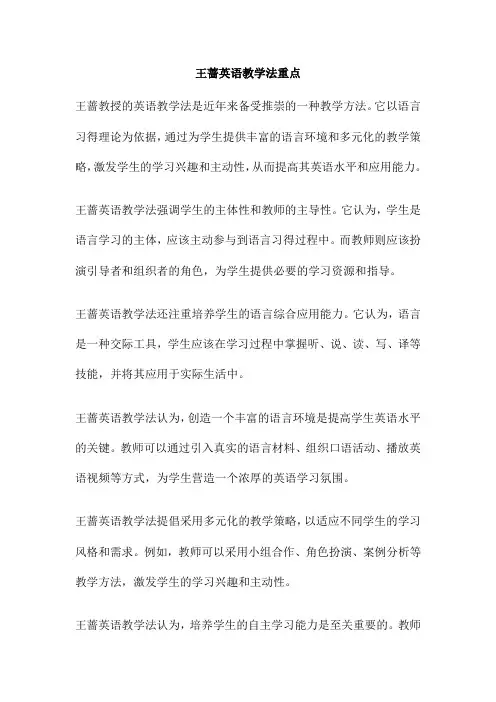
王蔷英语教学法重点王蔷教授的英语教学法是近年来备受推崇的一种教学方法。
它以语言习得理论为依据,通过为学生提供丰富的语言环境和多元化的教学策略,激发学生的学习兴趣和主动性,从而提高其英语水平和应用能力。
王蔷英语教学法强调学生的主体性和教师的主导性。
它认为,学生是语言学习的主体,应该主动参与到语言习得过程中。
而教师则应该扮演引导者和组织者的角色,为学生提供必要的学习资源和指导。
王蔷英语教学法还注重培养学生的语言综合应用能力。
它认为,语言是一种交际工具,学生应该在学习过程中掌握听、说、读、写、译等技能,并将其应用于实际生活中。
王蔷英语教学法认为,创造一个丰富的语言环境是提高学生英语水平的关键。
教师可以通过引入真实的语言材料、组织口语活动、播放英语视频等方式,为学生营造一个浓厚的英语学习氛围。
王蔷英语教学法提倡采用多元化的教学策略,以适应不同学生的学习风格和需求。
例如,教师可以采用小组合作、角色扮演、案例分析等教学方法,激发学生的学习兴趣和主动性。
王蔷英语教学法认为,培养学生的自主学习能力是至关重要的。
教师可以通过引导学生制定学习计划、评估学习成果等方式,帮助学生建立良好的学习习惯和自我管理能力。
王蔷英语教学法在实践中得到了广泛的应用,并取得了显著的效果。
许多研究表明,采用王蔷英语教学法的学生在英语水平和应用能力方面都有明显的提高。
这种教学方法也受到了广大教师和家长的欢迎和认可。
它不仅提高了学生的英语水平,还培养了他们的团队协作能力和自主学习能力。
王蔷英语教学法是一种先进、实用的教学方法。
它通过创造丰富的语言环境和多元化的教学策略,激发学生的学习热情和主动性,从而提高学生的英语水平和应用能力。
在未来的教育实践中,我们应该进一步探索和应用这种优秀的教学方法,为学生的全面发展提供更好的支持。
《英语教学法》是教育部普通高等教育“十一五”国家级规划教材,也是高等教育社的一本教材。
该教材的作者是王蔷教授,她是中国著名的英语教学法专家,拥有丰富的教学经验和深厚的学术背景。
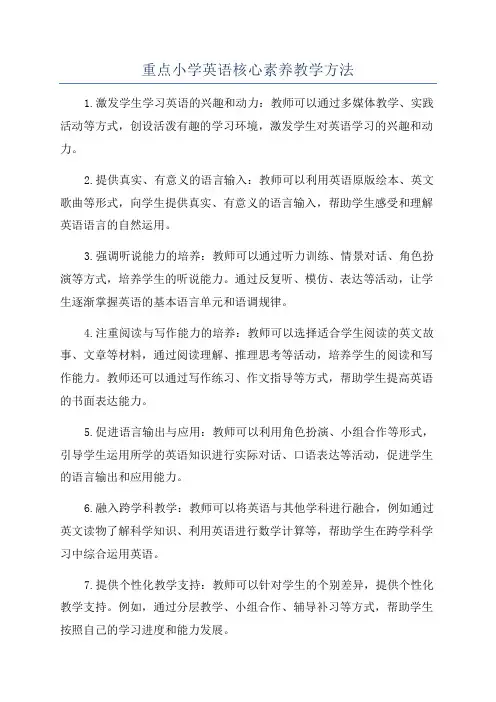
重点小学英语核心素养教学方法1.激发学生学习英语的兴趣和动力:教师可以通过多媒体教学、实践活动等方式,创设活泼有趣的学习环境,激发学生对英语学习的兴趣和动力。
2.提供真实、有意义的语言输入:教师可以利用英语原版绘本、英文歌曲等形式,向学生提供真实、有意义的语言输入,帮助学生感受和理解英语语言的自然运用。
3.强调听说能力的培养:教师可以通过听力训练、情景对话、角色扮演等方式,培养学生的听说能力。
通过反复听、模仿、表达等活动,让学生逐渐掌握英语的基本语言单元和语调规律。
4.注重阅读与写作能力的培养:教师可以选择适合学生阅读的英文故事、文章等材料,通过阅读理解、推理思考等活动,培养学生的阅读和写作能力。
教师还可以通过写作练习、作文指导等方式,帮助学生提高英语的书面表达能力。
5.促进语言输出与应用:教师可以利用角色扮演、小组合作等形式,引导学生运用所学的英语知识进行实际对话、口语表达等活动,促进学生的语言输出和应用能力。
6.融入跨学科教学:教师可以将英语与其他学科进行融合,例如通过英文读物了解科学知识、利用英语进行数学计算等,帮助学生在跨学科学习中综合运用英语。
7.提供个性化教学支持:教师可以针对学生的个别差异,提供个性化教学支持。
例如,通过分层教学、小组合作、辅导补习等方式,帮助学生按照自己的学习进度和能力发展。
8.倡导自主学习与合作学习:教师可以鼓励学生进行自主学习和合作学习。
例如,引导学生制定学习计划、进行学习小组合作、自主查找学习资料等,培养学生的学习自觉性和合作精神。
9.创设评价反馈机制:教师可以根据学生的学习表现,及时给予评价和反馈,帮助学生发现自身的问题,并提出相应的改进建议。
同时,教师还可以通过定期考试、学业竞赛等形式,激发学生的学习动力和提高学习效果。
10.培养学习策略和学习习惯:教师可以引导学生培养良好的学习策略和学习习惯,如合理安排学习时间、制定学习目标、积极参与课堂活动等,帮助学生养成有效的学习方法和习惯。
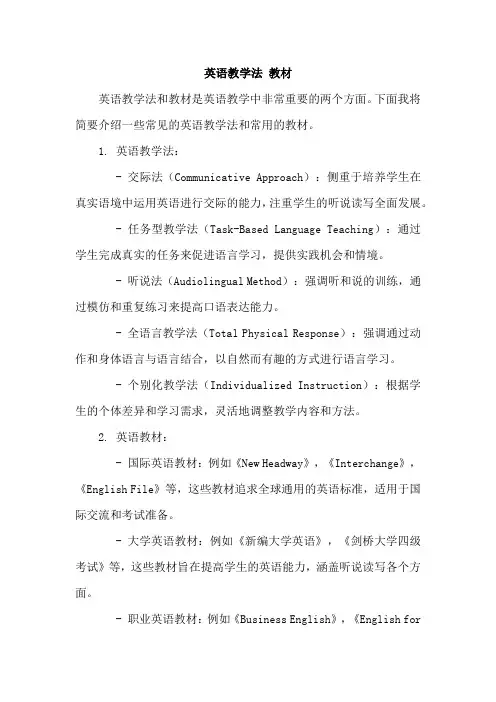
英语教学法教材
英语教学法和教材是英语教学中非常重要的两个方面。
下面我将简要介绍一些常见的英语教学法和常用的教材。
1. 英语教学法:
- 交际法(Communicative Approach):侧重于培养学生在真实语境中运用英语进行交际的能力,注重学生的听说读写全面发展。
- 任务型教学法(Task-Based Language Teaching):通过学生完成真实的任务来促进语言学习,提供实践机会和情境。
- 听说法(Audiolingual Method):强调听和说的训练,通过模仿和重复练习来提高口语表达能力。
- 全语言教学法(Total Physical Response):强调通过动作和身体语言与语言结合,以自然而有趣的方式进行语言学习。
- 个别化教学法(Individualized Instruction):根据学生的个体差异和学习需求,灵活地调整教学内容和方法。
2. 英语教材:
- 国际英语教材:例如《New Headway》,《Interchange》,《English File》等,这些教材追求全球通用的英语标准,适用于国际交流和考试准备。
- 大学英语教材:例如《新编大学英语》,《剑桥大学四级考试》等,这些教材旨在提高学生的英语能力,涵盖听说读写各个方面。
- 职业英语教材:例如《Business English》,《English for
Specific Purposes》等,这些教材侧重于特定行业或职业领域的英语应用。
- 儿童英语教材:例如《儿童英语》,《小学英语》等,这些教材通过游戏、歌曲和趣味练习等方式激发孩子对英语学习的兴趣。
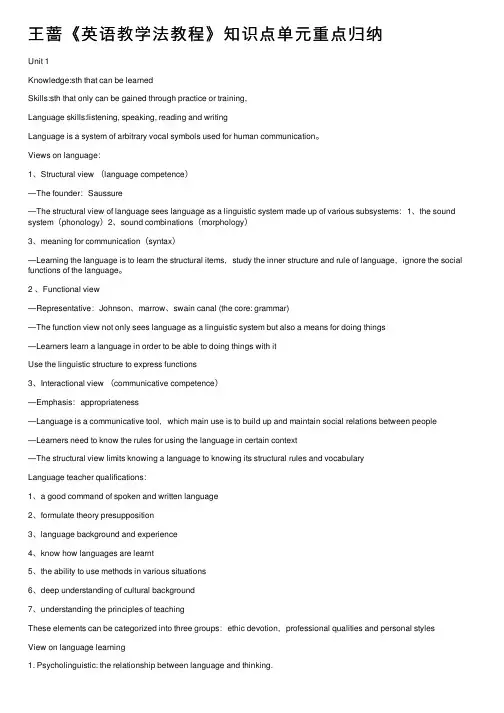
王蔷《英语教学法教程》知识点单元重点归纳Unit 1Knowledge:sth that can be learnedSkills:sth that only can be gained through practice or training,Language skills:listening, speaking, reading and writingLanguage is a system of arbitrary vocal symbols used for human communication。
Views on language:1、Structural view (language competence)—The founder:Saussure—The structural view of language sees language as a linguistic system made up of various subsystems:1、the sound system(phonology)2、sound combinations(morphology)3、meaning for communication(syntax)—Learning the language is to learn the structural items,study the inner structure and rule of language,ignore the social functions of the language。
2 、Functional view—Representative:Johnson、marrow、swain canal (the core: grammar)—The function view not only sees language as a linguistic system but also a means for doing things—Learners learn a language in order to be able to doing things with itUse the linguistic structure to express functions3、Interactional view (communicative competence)—Emphasis:appropriateness—Language is a communicative tool,which main use is to build up and maintain social relations between people —Learners need to know the rules for using the language in certain context—The structural view limits knowing a language to knowing its structural rules and vocabularyLanguage teacher qualifications:1、a good command of spoken and written language2、formulate theory presupposition3、language background and experience4、know how languages are learnt5、the ability to use methods in various situations6、deep understanding of cultural background7、understanding the principles of teachingThese elements can be categorized into three groups:ethic devotion,professional qualities and personal stylesView on language learning1. Psycholinguistic: the relationship between language and thinking.1)Thinking in language2)Language is necessary for thought.3)Language acquisition(语⾔习得)4)Learners in their earlier years acquire control over essential structure of their languagewithout special teaching and learning in a effortless and almost an unconscious way (like the formation of a habit) people prefer first language acquisition to first language learning.2.Cognitive theory: the rule for people to aware to cognize sth.Cognitive processes:Process: input----absorb----outputLanguage learning is not just stimulate-reflection, but the using of oursubjective capabilities, the using of our cognitive ability to think the language and studying it actively.3. Constructivist theory: learning is a process of meaning construction based on learner?s own knowledge and experience. S ----------AT------------R(刺激) (反应)Stimulus: assimilatio n ①and accommodatio n②①把外部知识纳⼊⾃⾝②纳⼊⾃⾝后也不相符,就要对原有知识进⾏改变,也就是⼀种原有知道和外部知识保持联系的创新的过程。
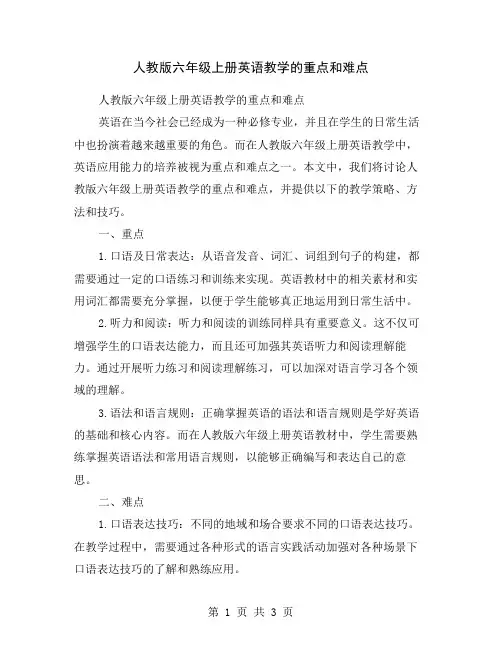
人教版六年级上册英语教学的重点和难点人教版六年级上册英语教学的重点和难点英语在当今社会已经成为一种必修专业,并且在学生的日常生活中也扮演着越来越重要的角色。
而在人教版六年级上册英语教学中,英语应用能力的培养被视为重点和难点之一。
本文中,我们将讨论人教版六年级上册英语教学的重点和难点,并提供以下的教学策略、方法和技巧。
一、重点1.口语及日常表达:从语音发音、词汇、词组到句子的构建,都需要通过一定的口语练习和训练来实现。
英语教材中的相关素材和实用词汇都需要充分掌握,以便于学生能够真正地运用到日常生活中。
2.听力和阅读:听力和阅读的训练同样具有重要意义。
这不仅可增强学生的口语表达能力,而且还可加强其英语听力和阅读理解能力。
通过开展听力练习和阅读理解练习,可以加深对语言学习各个领域的理解。
3.语法和语言规则:正确掌握英语的语法和语言规则是学好英语的基础和核心内容。
而在人教版六年级上册英语教材中,学生需要熟练掌握英语语法和常用语言规则,以能够正确编写和表达自己的意思。
二、难点1.口语表达技巧:不同的地域和场合要求不同的口语表达技巧。
在教学过程中,需要通过各种形式的语言实践活动加强对各种场景下口语表达技巧的了解和熟练应用。
2.词汇量扩大:在人教版六年级上册英语教材中,学生需要学习一定量的单词和常用短语,并要求在日常生活中熟练掌握和运用。
在教学中,老师可以通过贯穿知识点、实用单词和短语的练习来提高学生的词汇量。
3.听力和阅读理解能力:如果学生的听力和阅读能力不好,就难以理解开展语言交流、阅读课程和相关练习的意义。
在教学过程中,通过放慢和分步骤的讲解方法、多次听多次读的方式、多项阅读课程等手段来提高学生的听力和阅读理解能力。
三、教学策略1.教材分析:教师应该根据人教版六年级上册英语教材的特点和学习目标,结合实际情况进行详细的分析处理。
在教学过程中,老师可以通过详细分析教材,来确定教学目标,确保课程的有序展开。
2.开展互动:教学实践过程中,教师应充分利用各种教育资源和平台,开展各种形式的互动,以提高学生学习的积极性和主动性,提高学习效果,促进学生主动参与学习。
初中英语教学要点
初中阶段是英语研究的关键时期,以下是一些初中英语教学的
要点,供参考:
1. 创设良好的研究环境:营造积极、合作和友好的研究氛围,
鼓励学生参与课堂讨论和互动。
2. 提供大量的听力练:通过播放英语录音、演讲和对话等方式,让学生接触真实的英语语音和语调。
3. 培养语言能力:注重培养学生的听、说、读、写四个方面的
语言能力,通过不同的教学活动和练来提高学生的语言表达能力。
4. 强化基础知识:注重英语的基础知识教学,包括语法、词汇
和句型等,打好英语研究的基础。
5. 多媒体辅助教学:利用多媒体资源,如投影仪、电脑等,增
加学生对英语研究的兴趣和参与度。
6. 促进交际能力:通过角色扮演、小组讨论等方式,培养学生的英语交际能力,鼓励他们用英语进行真实对话。
7. 引导自主研究:教师应该引导学生主动参与英语研究,培养他们的自主研究能力,通过阅读、写作等活动来提高英语水平。
8. 课堂巡回检查:定期巡回检查学生的研究情况,及时发现问题并给予指导,帮助学生提高研究效果。
9. 教学反馈:及时给予学生针对性的反馈,激励他们研究英语的兴趣和动力。
10. 创学方法:不拘泥于传统的教学方法,尝试使用创新的教学手段和教材,提高教学效果。
希望以上初中英语教学要点能够对您有所帮助。
教学法期末本科重点Unit 1: language and language learningWhat is language:language is a system of signs, which is arbitrarily chosen, vocal, conventionalized, graphic, and gesture symbol for verbal communication in a given society.Design features: refer to defining properties of human language that tell the difference between human language and any system of animal communication. They are arbitrariness, duality, productivity, displacement, cultural transmission, and interchangeability. Features of language 和views on language 在P-3 Several theories on language learning (behaviourist theory ,cognitive theory,constructivist theory, socio-constructivist theory)在P5-P6A good language teacher’s features (ethic devotion, professional qualities, personal styles, language competence)Unit 2:communicative principles and TBLTCLT(goal在P-16): communicative language teaching TBLT(在P-27): Task-based language teachingGoal of foreign language teaching: to enable students touse the foreign language in work or life when necessary Difference between language use in real life and traditional pedagogyCommunicative competence(linguistic competence, pragmatic competence, discourse competence, strategic competence, fluency) 在P-18Sever linguistics’ ideas about exercise types and activities (Richards, Rodgers, Finocchiaro, Brumfit, Ellis, Littleword.)在P-23下TBLT:(P-27)Task:(purpose,context,process,product)Exercise-task(P-28)PPP:(presentation,practice,production)在P-31 Differences between PPP and TBL(task-based learning P-31)在P-32How to design tasks(have four steps) 在P-34Brief history of foreign language teaching in china (before1978, 1978—1985, 1986- 1992, 1993—2000, after2000)在P39-41Unit 4 Lesson planningDefinition of lesson planning在P-51,Significant在P-52Principles for good lesson planning(aim, variety, flexibility, learnability, linkage)在P-53Macro planning and micro planning 在-P54 Components of a lesson planning (background information, teaching aims, language contents and skills, stages and procedures, teaching aids, end of lesson summary, optional activities and assignments, after lesson reflection )在P56-60Unit 5 classroom managementThe role of teacher(controller,assessor,organiser, prompter, participant and resource provider, facilitator, guide, researcher )在P68-72Classroom instructions 在P-73Student grouping (whole class work, pair work, group work, individual study 在P-75) Methods在P-75-76 Definition of discipline and indiscipline 在P-78 Harmer(1983) suggests the following measures for indiscipline acts and bad behaving students (act immediately, stop the class, rearrange the seats, change the activity, talk to students after class, create a code of behaviour.) 在P-81Ur gives the following way to solve these problems (dealwith it quietly, do not take things personally, do not use threats.)在P81-82Lavery’s idea about how to solve problems在P-82The use of questioning in the classroom在P-83The classification of question types (closed, open, display, genuine, lower-order, higher order questions)在P-83Unit 6 teaching pronunciationPhonetic rules regarding what sounds a letter or a cluster of letters should be pronounced are helpful for students to develop ability to cope with English pronunciation and they should be introduced at a suitable stage.在P-91Stress and intonation are as important as the sounds themselves and should be taught from the very beginning. 在P-91The goal of teaching pronunciation 在P-92-93 Aspects of pronunciation (sounds, phonetic symbols, stress, intonation, rhythm)在P-93Practicing sounds (focusing on a sound, perception practice-using minimal pair, production practice)在P-95-98。
1.Views on language: a. Structural view(结构主义) b. Functional view(交际法) c. Interactional view(交往法)1) The structural view结构主义观点:language as a linguistic system made up of various subsystems: from phonological, morphological, lexical, etc. to sentences. Each language has a finite number of such structural items.To learn a language means to learn these structural items so as to be able to understand and produce language.2)The functional view交际法的观点language as a linguistic system but also as a means for doing things. Most of our day-to-day language use involves functional activities: offering, suggesting, advising, apologizing, etc.3)The interactional view交往法的观点Language is a communicative tool, whose main use is to build up and maintain social relations between people. Learners not only need to know the grammar and vocabulary of the language but as importantly they need to know the rules for using them in a whole range of communicative contexts.The interactional view says that to know how to do what one wants to do involves also knowing whether it is appropriate to do so, and where, when and how it is appropriate to do it. In order to know this, the learner has to study the patterns and rules of language above the sentence level to learn how language is used in different speech contexts.2.The qualities of teachers教师素质:ethic devotion; professional qualities; personal styles.municative competence(交际能力组成的5部分): a. linguistic competence b. pragmatic competence c. discourse competence d. strategic competence e. fluency4. Principles of communicative language teaching: a. communication principle b. task principle c. meaningfulness principle5.classification of communicative activities(交际活动的分类): a. functional communicative activities b. social interaction activities6.The role of teacher 教师的角色:a. controller b. assessor c. organizer d. prompter e. participant f. resource-provider 7. Classroom instructions: Classroom instructions refer to the type of language teachers use to organize or guide learning. They include giving directions to tasks or activities, providing explanations to a concept or language structure, setting requirements, checking comprehension, drawing attention, motivating learners, giving feedback, and assigning homework, etc.8. students grouping: a. whole class work b. pair work c. group work d. individual study6\7\81.Three ways to show the stress pattern words, phrases and sentences:1)Use gesture;2)Use the voice;3)Use the blackboard.2.Factors contribute to successful practice:1) pre-learning 2) volume and repetition 3) success-orientation 4) heterogeneity 5) teacher assistance 6) interest3.Grammar practice is usually divided into 2 categories: mechanical practice & meaningful/communicative practice.4.Mechanical practice involves activities that aimed at form accuracy.5.What does it mean to know a word? Knowing a word mans 1) knowing its pronunciation and stress; 2) knowing its spelling & grammatical properties; 3) knowing its meaning; 4) knowing how & when to use it to express the intended meaning.9\10\111. Principles for teaching listening 1).focus on process.2).combine listening with other skills.3).focus on the comprehension of meaning.4).grade difficulty level appropriately.2. Factors that affect the difficulty level of listening tasks, but they fall into 3 main categories:1)type of language used.2)task or purpose in listening.3)context in which the listening occurs.3. Models for teaching reading:1)Bottom-up model.(2)Top-down model 3)Interactive model4.The characteristic are common in successful speaking tasks:1) Maximum foreign talk; 2)Even participation;3)High motivation;4)Right language level.5. Littlewood divides communicative speaking activities into 2 types: Communicative activities: functional communication activities and social interaction activities. It also includes Pre-communicative activities: structural activities andQuasi-communicative activities. Pre-communicative activities are intended to prepare learners for Communicative activities. 6. Pre-reading activities: predicting; setting the scene; skimming; scanning. Skimming means reading quickly to get the gist,e.g.the main idea of the text. Scanning which means to read to locate specific information.7.Some speaking activities:1)controlled activities: mainly focus on form and accuracy; 2)semi-controlled activities: focus on meaning and communication; 3)communicative activities.8. Ur points out that factors that affect the success of role-plays are: 1)the teacher’s enthusiasm;2)careful instructions;3)clear situations and roles; 4)and making sure that the students have the language they will need to carry out the role-play.1.The main procedures of process writing(过程写作)include: Creating a motivation to write; brainstorming; mapping; freewriting; outlining; drafting; editing; revising; proofreading and conferencing.2. Principles can help teachers motivate students to write: 1) Make the topic of writing as close as possible to students’ life.2) Leave students enough room for creativity and imagination. 3) Prepare students well before writing. 4) Encourage collaborative group writing as well as individual writing. 5) Provide opportunities for students to share their writings. 6) Provide constructive and positive feedback. 7) Treat students’’ errors strategically. 8) Give students a sense of achievement from time to time.1.我国英语教学的六个基本原则原先所倡导的中学英语教学的基本原则:1、交际性原则2、阶段侧重原则3、语音词汇语法综合教学原则4、使用和控制使用本族语的原则5、以学生为中心的原则。
Views on language learning and learning in general(1)Behaviorist theory Eg;you can train an animal to do anything if you follow a certain procedure which has three major stages,stimulus,response,and reinforcement(2)Cognitive theory\(3)Constructive theory(4)Socio-constructivist theory Eg:learning is the best achieved through the dynamics interactions between the teacher and the learners.What makes a good teacher?(1)ethic devotion(2)Professional qualities(3)Personal stylesHow can one become a good language teacher?(1)the development of professional competence (most difficult)(2)A specific range od skills strategies,,knowledges and ability(3)Have a sound command of English(4)Learning practice and reflection.learning from others experience.leaning the received knowledge leaning from one’s own experience as a learner.Language use in real life VS traditional pedagogy(1)in real life,language is used to perform certain communicative functions. Eg: to give directions,to exchange information or to make a complaint. In traditional language classroom,the teaching focus is often on forms rather than functions.(2)For various reasons,traditional pedagogy tends to focus on two language skills and ignore the others. Eg:the grammar-translation methos emphasized on reading and writing skills and virtuallyignored listening speaking skills.(3)In reality language is always used in a certain context,but traditional pedagogy tends to isolated language from its context. Eg:when the English passive voice is introduced,the teacher always focuses on the explanation of how the objects in an active sentence is moved to the front of a passive sentence. And how the verb is changed to an auxiliary plus an -ed form of the base form of the verb.What is communicative competence ?(1)linguistic competence(2)Pragmatic competence(3)Discourse competence(4)Strategic competence(5)FluencyTask based language teachingTask definitionIs a piece of work undertaken for oneself or for others,freely or for some reward.Is an activity which requires learners to arrive at an outcome from given information through some process of thought,and which allows teachers to control and regulate that processFour components of a taskA purpose :make sure the students have a reason for undertaking the taskA context :this can be real simulated or imaginary and involves sociolinguistic issues such as the location the participants and their relationship,the time,and other important factors.A process;getting the students to use learning strategies such as problem solving reasoning inquiring conceptual and communicatingA product : there will be some form of outcome either visible or invisibleExercises tasksFocus form meaningSituation no situation real life situationOutcome correct form accomplishment of taskLanguage practice of assigned form choice of form and contentError immediate correction delayed correctionPrinciples for good lesson planning(1)Aims means a realistic goals for the lesson the teacher needs to have a clear idea of what he or she would like to achieve for the lesson or what outcomes are expected from the lesson Aims are not the things teachers intend to do during the lesson,but the things that students are able to do bu the end od the lesson.(2)Variety means planning a number of different types of activities.(3)Flexibility means preparing some extra and alternatives tasks and activities as the class does not always go according to the plan(4)Learnability means the contents and tasks planned for the lesson should be within the learning capabilities of the students.(5)Linkage means linked with each otherHarmer suggest the following measures for indisciplined acts and badly behaving students(1)Act immediately(2)Stop the class(3)Rearrange the seats(4)Change the activity(5)Talk to students after class(6)Create a code of behaviorDealing with errors(1)dealing with spoken errors(2)When to correct generally it is best to interrupt students during fluency work unless communication breaks down.if the students has got most of his language right but has made a trivial mistakes it is sometimes wise to let the mistakes pass if there are some common mistakes that other students might also have problems with,the teacher can take a note in his or her mind and try to do the correction after the students’ performance.(3)How to correct indirect teacher correction is encouraged to avoid damaging students’self esteem and confidence. Ask a question to invite the students to say it again with a hint of a problem. Sometimes the whole class can be invited to correct the mistakes.Characteristics of the listening process(1)spontaneity(2)Context(3)Visual clues(4)Listeners ‘s response(5)Speakers’ adjustmentA process approach to writing(1)Focus on the process of writing that leads to the final written process(2)Help students writers understand their own composing process(3)Help them built repetoires of strategies for previewing drafting and rewriting(4)Palace central importance on the process of reversion(5)Give students time to write and rewrite(6)Let the students discover what they want to say as they write(7)Give students the feedback throughout the composing process to consider as they attempt to bring their expression closer and closer to intention(8)Encourage feedback both from the instructors and peers(9)Include individual conferences between teacher and student during the process of composition。
❤判断主张并简要说明理由:Structural view:The structure language sees language as a linguistic system made up of various subsystems:phonology,morphology and syntax.To learn a language means to learn these structural items so as to be able to understand and produce language.Functional view: The functional view is not only sees language as a linguistic system but also a means for doing things,such as offering suggesting,etc.Leaners need to know how to combine the grammatical rules and the vocabulary to express notions that perform the functions. International view:The international view considers language to be a communicative tool,whose main use is to build up and maintain social relations between people.Leaners not only need to know the grammar and vocabulary but also need to know the rules for using them in a communicative contexts.❤What makes a good language teacher?These elements can be categorized into three groups:ethic devotion,professional qualities and personal styles.❤教师的专业能力是如何发展起来的(How can be a good teacher/The development of professional competence)答:The development of professional competence including three parts: Stage1,Stage2 and Goal.I. The first stage is language development.All English teacher are supposed to have a sound command of English,and language is always changing,language development can never come to an end.II. The second stage is the most important stage and it is more complicated because it involves three sub-stages:learning,practice,and reflection.(1)The learning stage is the purposeful preparation before a teacher starts the practice of teaching.It includes three parts:learning from other's experience,learning the received knowledge and learning from one's experiences.Both experience knowledge and received knowledge are useful when a teacher goes ton practice.(2)The term 'practice' can be used in two senses. One sense is also called pseudo practice.The other sense is the real classroom teaching.(3)Teacher benefit from practice if they keep on reflecting on what they've done,Not only after they finish their practice,but also while they are doing the practice, III. After some period of practice and reflection,a teacher should be able to reach his or her professional competence.As an final it shouldn't an end,one must be keep learning,practicing and reflecting.❤真实应用语言&课堂语言的不同(The differences between language used in real life and language taught in the classroom.)Language used in real life differs from language learned under the traditional language teaching pedagpgy in the following aspects:(1)In real life,language is used to perform certain communication functions;in a traditional language classroom,the teaching focus is often on forms rather than functions.(2)For various reasons,traditional pedagogy tends to focus on one or two language skills and ignore others.In real language use we use all skills,including receptive skills and productive skills.(3)In reality language is always used in a certain context,but traditional pedagogy tends to isolate language from its context.❤交际教学法的目标The goal of CLT is to develop students'communicative competence,which includes both the knowledge about the language and the language about how to use the language appropriately in communicative situations.★★★交际的五个方面(名词解释or简答)There are five main components of communicative ly,linguistic competence,pragmatic competence,discourse competence,strategic competence,and fluency.Linguistic competence is concerned with knowledge itself,its form and meaning.(It involves spelling, pronunciation, vocabulary, word formation, grammatical structure,sentence structure,and semantics.It is an integral part of communicative competence.)Pragmatic competence is concerned with the appropriate use of the language in social context.(That is to say,the choice of the vocabulary and structure depends on the setting,the relative status of the speakers,and their relationships.)Discourse competence refers to one's ability to create coherent written text or conversation and the ability to understand them.(According to Hedge,also includes one's ability to initiate,develop,enter,interrupt,check,or confirm in a conversation.)Strategic competence is similar to communication strategies.It refers to strategies one employs when there is communication breakdown due to lack of resources.One can compensate for this by searching for other means of expression.Fluency means one's ability to 'link unit of speech together with facility and without strain or inappropriate or undue hesitation.❤Principles of communicative language teaching.(交际教学语言CLT原则)(1).Communication principle:Activities that involve real communication promote learning.(2)Task principle:Activities in which language is used for carring out meaningful tasks promote learning.(3)Meaningfulness principle:language that is meaningful to the learner supports the learning process.❤交际教学法&语言技能的关系(CLT and the teaching of language skills )(听说读写在交际教学法中怎样。
英语教学法重点Unit 1 Language and Learning?1.1 How do we learn languageWe learn language at different agesPeople have different experiencesPeople learn languages for different reasonsPeople learn languages in different waysPeople have different capabilities in language learning Learning can be affected by the way how language is taught Learning is affected by the degree of success one is expect to achieve.Thus the challenge confronting language teaching is how teachingmethodology can ensure successful learning by all the learners who havemore differences than the commonality.1. 2 What are the major views of language?1) Structural view:Language is a linguistic system made up of various subsystems: phonology, morphology, lexicology and syntacx. To learn a language isto learn its vocabulary and structural rules.英语教学法重点2) Functional view:Language is a linguistic system as well as a means for doing things.Learners learn a language in order to be able to do things with it (useit). To perform functions, learners need to know how to combine thegrammatical rules and the vocabulary to express notions that performthe functions.3) Interactional view:Language is a communicative tool to build up and maintain social relations between people. Learners need to know the rules of a languageand where, when and how it is appropriate to use them.1.3Views on Language LearningTwo broad learning theories:Process-oriented theories are concerned with how the mind organizesnew information.Condition-oriented theories emphasize the nature of human and physical context.Behaviorist theoryB. F. Skinner?英语教学法重点A stimulus-response theory of psychology?Audio-lingual method?The idea of this method is that language is learned by constant ?repetition and the reinforcement of the teacher. Mistakes wereimmediately corrected, and correct utterances were immediately praised.Cognitive theory B.Influenced by Noam Chomsky (revival of structural linguistics)?Language as an intricate rule-based system?produce to him A learner acquires language competence which enables ?language.One influential idea of cognitive approach to language teaching ?is that students should be allowed to create their own sentence basedon their own understanding of certain rules.Constructivist theory C.Jean Piaget (1896—1980)?The learner constructs meaning based on his/her own experiences ?and what is already known.Socio-constructivist theory D.英语教学法重点Vygotsky?“Zone of Proximal Development” (ZPD); scaffolding (脚手架)?Learning is best achieved through the dynamic interaction between ?the teacher and the learner and between learners.1.4 What are the qualities of a good language teacher?A good language teacher does not solely depend on his/her commandof the language. There are a variety of element that contributes to thequalities of a good language teacher. These element can be categorizedinto three groups:ethic devotion, professional quality and personalstyles.1.5 How can one become a good language teacher?Wallace's (1991) ‘reflective model' (Figure 1.1, p.9)?英语教学法重点Stage 1: language developmentStage 2: learning, practice, reflectionThe learning stage is the purposeful preparation that a language?normally receives before the practice,This preparation can include:1. Learning from others' experience2. Learning the received knowledge3. Learning from one's own experiencesThe practice stage (2 senses)?Pseudo practice: short period of time assigned to do teaching practice as part of one's pre-service education, usually under the supervision of instructorsThe real classroom teaching: what a teacher undertakes after he/she finishes formal educationTeachers benefit from practice if they keep on reflecting on ?what they have been doingGoal: professional competenceUnit 2 Communicative Principles and Task-based language teaching英语教学法重点2.1 How is language learned in classrooms different from languageused in real life?Language used in real lifeLanguage taught in the classroomTo focus on forms (structures or To perform certaincommuntcative patterns)functionsUse all skills, both receptive To focus on one or two languageskills skills and ignore others. and productive skillsUsed in a certain context To isolate language from itscontext2.2 What is communicative competence?To bridge the gap between classroom language teaching and real-lifelanguage use, one solution is to adopt CLT, the goal of which is todevelop students' communicative competence.Definition:Communicative competence include both the knowledge about the language and the knowledge about how to use the language appropriatelyin communicative situationsFive components of communicative competence (Hedge 2000) Linguistic competence (语言能力)?The knowledge of language itself, its form and meaning.Pragmatic competence (语用能力)?英语教学法重点The appropriate use of language in social context.Discourse competence (语篇能力)?One's ability to create coherent written text or conversation and the ability to understand themStrategic competence (策略能力)?Strategies one employs when there is communication breakdown due to lack of resources.Fluency(流利性)?One ‘s ability to ‘link units of speech together withfacility and without strain or inappropriate slowness or undue (过分的,不适当的) hesitation'2.3Implications for teaching and learningTeaching must enable learners to grasp the five components of communicative competence, but not just the linguistic competence.2.4 Principles of CLTThree principles suggest by Richard and Rodgers:1 Communication principle:involve real communication2 Task principle:Carry out meaningful tasks英语教学法重点3 Meaningfulness principle:Meaningful language to the learner Howatt proposes a weak and a strong version of CLT:Weak versionLearners first acquire language as a structural system and then learn how to use it in communication.Strong version“language is acquired through communication” (Howatt, 1984:279)2.5 Major Activity Types of CLTA sequence of activities represented in Littlewood (1981: 86) Pre-communicative activitiesStructural activities?Quasi-communicative activities类似,准,半?Communicative activities(PP22-23)Functional communication activities?Social interaction activities?2.6 Six Criteria for evaluating communicative classroom activities(main features of communicative activities?)英语教学法重点Communicative purpose?Communicative desire?Content, not form?Variety of language?No teacher intervention?No materials control?2.7 What is Task-based Language Teaching?TBLT is a further development of CLT. It shares the same belief inthe use of language in real life, but stresses the importance to combineform-focused teaching with communication-focused teaching. Four components of a taskA purpose 1.A context 2.A process3.A product4.Exercises, exercise-tasks and tasks英语教学法重点kind This and between tasks exercises. Exercise-tasks is halfwayof activity consists of contextualized practice of language item.2.8 Differences between PPP and TBLTradically TBLT is language use and experience in students 1 The waydifferent from PPP.*Free of language control*A genuine need to use language to communicate*A free exchange of ideas*Appropriateness & accuracy of language form in general, not production of a single form*A genuine need for accuracy and fluencyform-focused teaching and grammar context provide 2. TBL can a foractivities. PPP is英语教学法重点different in this aspect.■A task-established contextEncouraged to think, analyze, not simply to repeat, manipulate and ?applyA more varied exposure to natural language?Language forms not pre-selected for focus?Learner-free selection of language?TBL cycle lead from Fluency to accuracy(+fluency)?In TBL Integrated skills practiced?2.9 How to design tasks?Step 1 Think about students' needs, interests, and abilities Step 2 Brainstorm possible tasksStep 3 Evaluate the listStep 4 Choose the language itemsStep 5 Preparing materials2.10 CLT and TBLT in the Chinese contextProblems with CLT?英语教学法重点1. The very first and forceful argument is whether it is culturallyappropriate2. The second problem of CLT relate to the design the syllabus forteaching purpose in the classroom.3. The third problem is that whether such an approach is suitablefor all age level of learners or all competence level of learners.Constraints of TBLT?The first is it may not be effective for presenting new language items?The second constraint is Time as teachers have to prepare task-based?activities very carefully.The third is the culture of learning?The forth is Level of difficulty?Unit 33.1 A brief history of foreign language teaching inA phase of restoration (1978-1985)?A phase of rapid development (1986-1992)?A phase of reform (1993-2000)?A phase of innovation from 2000?英语教学法重点3.2 Designing principles for the National English Curriculum 1) Aim for educating all students, and emphasizequality-oriented education.2) Promote learner-centeredness, and respect individual differences.3) Develop competence-based objectives, and allow flexibility andadaptability.4) Pay close attention to the learning process, and advocate experiential learning and participation.5) Attach particular importance to formative assessment, and give special attention to the development of competence.6) Optimize learning resources, and maximize opportunities for learning and using the language.3.3 Goals and objectives of English language teachingThe new curriculum is designed to promote students' overalllanguage ability, which is composed of five interrelated components,namely, language skills, language knowledge, affects, learning strategies and cultural understanding. Each component is furtherdivided into a few sub-categories. Language teaching is no longer aimedonly for developing language skills and knowledge, but expanded to英语教学法重点developing learners' positive attitude, motivation, confidence aswell as strategies for life-long learning along withcross-culturalknowledge, awareness and capabilities.The overall language ability required in the 2001 National EnglishCurriculum includes the following aspects language knowledge, languageskills, learning strategies, affects and cultural understanding.3.4 Design of the National English Curriculum3.5 The standards for different levels of competence英语教学法重点3.6 Challenges facing English language teachersEnglish language teachers are expected to change their views 1)means a linguistic knowledge but system about language which is not a offor communication.English language teachers are expected to change their 2) traditional role of a knowledge transmitter to a multi-role educator.task-based use more teachers language are expected to 3) Englishactivities and put the students at the center of learning.English language teachers are expected to use more formative 4)assessment in addition to using tests.English language teachers are expected to use modern 5)learning for effective teaching, creating more resources in technologyand for using the language.备课Unit 4. Lesson Planning英语教学法重点4.1 why is Lesson Planning ImportantA lesson plan is a framework of a lesson in which teachers make advance decisions about what they hope to achieve and how they wouldlike to achieve it.Proper lesson plan is essential for both novice and experienced teachers. Language teachers benefit from lesson planning in a numberof ways.Makes teachers aware of the aims and language contents of the 1.lesson, so as to plan the activities and choose the techniquesaccordingly;Helps teachers distinguish the various stages of a lesson and 2.see the relationship between them so that the activities of different difficulty levels can be arranged properly and the lesson can move smoothly from one stage to another;Gives teachers the opportunity to anticipate potential problems3.so that they can be prepared;Gives teachers, esp. novice ones, confidence in class; 4. Raises teachers' awareness of the teaching aids needed; 5. Planning is a good practice and a sign of professionalism. 6.英语教学法重点Teachers benefit from proper lesson plans in a number of other ways:To enable the teacher to improve class timing;?Lesson plans are also an aid to continuingdevelopment?(plan-practice -reflection)4.2 Principles for Good Lesson PlanningAim: the realistic goals for the lesson; what students are able 1.to do by the end of the lesson;Variety: different types of activities; a wide selection of 2.materials;Flexibility: preparing some extra and alternative tasks and 3.activitiesLearnability: the contents and tasks planned should be within 4.the learning capability of the studentsDoing things that are beyond or below the students' coping ability will diminish their motivation (Schumann, 1999)Linkage: the stages and the steps within each stage are linked 5.with one another.4.3 what are macro planning and micro planning?英语教学法重点Macro planningPlanning over a long period of time which is often done by a groupof teachers, it provides a general guidance for language teachersMicro planningPlanning for a specific unit or a lesson, which usually lasts fromone to two weeks or forty to fifty minutes respectively. Micro planningis often an individual activity and different teachers may have different ways of writing their own lesson plans.Macro planning involves the following:?Knowing about the professionKnowing about the institutionKnowing about the learnersKnowing about the curriculum/syllabusKnowing about the textbookKnowing about the objectivesA lesson plan usually has the following components: Background information?英语教学法重点Teaching aims?Teaching content and skills?Stages and procedures?Teaching aids?End of lesson summary?Optional activities and Assignment?After lesson reflection?Unit 5 Classroom Management5.1 What is classroom management?Classroom management is the way teachers organize what goes on in the classroom. (68)the goal of classroom management is to create an atmosphere conducive to (有助于)interacting in English in meaningful ways (Gebhard,1996).Efficient classroom management can be achieved when the followingsix conditions are met.The teacher plays appropriate roles. 1.The teacher provides clearer instructions. 2.Students are grouped in a way suitable for the learning activities. 3.There is discipline as well as harmony in the class. 4.The teacher asks appropriate questions. 5.The students' errors are treated properly 6.5.2 What roles does the teacher play?Controller (what to learn; how to learn) 1.Assessor (correcting mistakes; organizing feedback) 2.Organiser (students' activities)3.Prompter (when ss don't know what to do (4)Participant (in ss' activities)5.Resource-provider6.Teachers' roles are not static. They change with the developmentof the society.New roles:?Teacher as facilitator?Create a positive learning environment, use various strategies to?motivate learners, guide students in planning and assessing theirlearning and develop their learning strategies…Teacher as guide?Activate students' prior knowledge; find individual interests and?explore potential capabilities; acknowledge and respect individualdifferences; give each equal opportunity in learning; evaluate students' development fairly from an all-round perspective…Teacher as researcher?Observe a problem, reflect on the reasons, think about possible?solutions, implement the solutions and evaluate the results…Q: How much control is needed?Appropriate degree of control?Different activities need a different degrees of control.? The more communicative an activity, the less control it needs.?Q: What does the teacher do as an assessor? Correcting mistakes 1.The correcting should be gentle, not harsh.?Organizing feedback 2.The feedback should be focused on students' success or progress so?that a success-oriented learning atmosphere can be created.英语教学法重点Q: How to organise?Before the activity: what the activity is going to be like, ?anticipated problems; clear instructions given to students (withT's demonstration)During the activity: overhear what the students are saying, rectify?wrong practices; take notes for later feedbackQ: When to prompt?When students are not sure how to start an activity, or what to do?next, or what to say next…When a student doesn't seem to be ready for an answer,…?When a student finishes with a very short answer,…?Q: why to participate in student's activities?Monitoring + participating changes the role from an authority to?a conversationalist, a good chance for students to practise Englishwith a superior…Q: What do you think of the jug-and-mug metaphor?Although the jug-and-mug method has been widely criticised, the teacher is still considered a good and convenient resource forthestudents.”英语教学法重点5.3 How to give effective classroom instructions?Classroom instructions refer to the type of language teachers useto organize or guide learning.To use simple instructions and make them suit the comprehension level1.of the students;To use the mother-tongue only when it is necessary; 2.Give students time to get used to listening to English instructions; 3.Use body language to assist understanding; 4.Model thetask/activity before letting students into groups or5.pairs…Teachers are not expected to do all the talking in class. 6.Tip: Demonstration is usually more effective than words.5.4 What are the different ways for student grouping?Whole class work, pair work, group work, individual study? Whole class work 1.All the students are under the control of the teacher, doing the same?activity at the same rhythm and pace.Pair work 2.英语教学法重点Students work in pairs on an exercise or task.?Group work 3.Students work in small groups of 3-5 students.?Individual study 4.Students work on their own at their own speed.?Q: How to group? (Grouping methods)Whole class work is normally used when presenting and explaining newnguage or new information and it should be used wisely by theteachers.Successful group/pair work depends on skillful organization.2.The biggest problem for group work is the selection of group members.3.While teachers are encourage to use pair wok and group work to provide4.more practice chance, individual study should not be forgotten.Types of student grouping and their advantages and disadvantagesin P314 (task4)5.5 Discipline in the language classroomQ: What does discipline mean?英语教学法重点Discipline refers to a code of conduct which binds a teacher anda group of students together so that learning can be more effective.(78)Q: Does discipline guarantee effective learning?No. There might be little learning even the class is very?disciplined.Although discipline is necessary, it is not a sufficient condition?for effective learning as a thoroughly indisciplined atmosphere willsurely yield no learning at all. (79)Q: How to maintain discipline?P.79Although discipline is often discussed together with classroom management, Classroom management skills are not sufficient if discipline is to be achieved,rather,a variety of teacher's behaviorcontribute to discipline, such as the teacher's choice of methodology, their interpersonal relationships with students,preparation for the lesson. Beside, student's motivation, which canbe enhanced by the teacher action, is extremely important for discipline.When students are engaged in learning, they will be disciplined.(79)英语教学法重点Ss are clear about learning purpose;?Ss are able to do the work but find it challenging;?Ss are emotionally, physically and intellectually involved by the?tasks;The presentation, variety and structure of the work and activities?generate curiosity and interest;Ss have opportunities to ask questions and try out ideas;? Ss can see what they have achieved and how they had made progress;?Ss get a feeling of satisfaction and enjoyment from the work.?Q: What causes discipline problems?A gap in the lesson (e.g. bad planning, equipment fails toUnclear instructions?Lack of teacher attention?The teacher concentrates on lengthy explanations to one individual?so that the others get boredWork is too easy or too challenging?Q: What measures can we take for undisciplined acts and badly behaving students?英语教学法重点Harmer (1983) p.81?Act immediately. 1.Stop the class.2.Rearrange the seats.3.Change the activity.4.Talk to students after class.5.Create a code of behavior. 6.'s (1996) advice?Deal with it quietly. 1.Don't take things personally. 2.Don't use threats. 3.5.6 How to make questioning more effective?Questions should be closely linked to the learning objectives in?the lesson;Questions should be staged so that the level of challenge increases?as the lesson proceeds;There should be a balance between closed and open, lower-order and?higher-order questions;英语教学法重点Wait time is important to allow students to think through their ?answers;Ss should be provided opportunities to ask their own questions and?seek their own answers;A secure and relaxed atmosphere of trust is needed and ss' opinions?and ideas are valued.What types of questions are there?( Classification of questions)Closed and open questions; 1.Display and genuine questions;2.Lower-order and high-order questions;3.Bloom's taxonomy 分类系统(Nuttall, 1982)4.Knowledge①Comprehension②Application③Analysis④Synthesis⑤Evaluation⑥5.7 Dealing with errors英语教学法重点Q: What are errors? How are they different from mistakes?A mistake refers to “a performance error that is either a random ?guess or a ‘slip of tongue', and it is a failure performance to aknown system” (Brown, 2000: 218-219)An error has direct relation with the learner's language?competence. Errors do not result from carelessness nor hesitation,but lack of knowledge in the target language.A mistake can be self-corrected; an error cannot be.?Q: How to deal with errors?In dealing with errors and mistakes we need to be clear whether ?the task or activity is focusing on accuracy or fluency. Q: When to correct errors?Generally, it is best not to interrupt students during fluency work?unless communication breaks down.Let a trivial mistake pass if most of the language is right.? For some common mistakes, take a note in mind first and correct ?after the student's performance.Q: How to correct errors?Different ways and techniques:?英语教学法重点Direct teacher correction?Indirect teacher correction?Self-correction?Peer correction?Whole class correction?Q: Which techniques to use?As a general rule, indirect teacher correction is encouraged ?rather than direct ones to avoid damaging ss' self-esteem and confidence.In practice, self-correction is encouraged before teacher?correction or peer correction, esp. for mistakes.The whole class correction is used for main error types (e.g.The ?Big Ten)Summary1.Roles of the teacher: controller, assessor, organiser, prompter,participant, resource-provider, facilitator, guide, researcher,etc.英语教学法重点2.Classroom instructions: simple; suit the level of students3.Grouping: whole class work, group work, pair work, individual study4.Discipline: to engage ss in learning; how to maintain discipline,how to treat with undisciplined acts5.Questioning: different classifications; questioning techniques6.Error correction: error and mistake; different ways and techniquesfor correcting errorsUnit 6 Teaching PronunciationCritical Period Hypothesis: a biologically determined period oflife when language can be acquired more easily and beyond which timelanguage is increasing difficult to acquire.6.1 The role of pronunciationDebate?Side A: students do not need to learn pronunciation becausepronunciation will take care of itself as the students develop overalllanguage ability.Side B: Failure in pronunciation is a great hindrance to languagelearning.Views of teaching pronunciation vary英语教学法重点The Learners who have more exposure to English need less focus on?pronunciation than those who only learn English in the class. Adult learners need more focus on pronunciation because they are more?likely to substitute English sounds with sounds from their nativelanguage.The teaching of pronunciation should focus on the ss' ability to?identify and produce English sounds themselves. (pronunciation vs.phonetics)Ss should not be led to focus on reading and writing phonetic ?transcripts of words, esp. for young students.Phonetic rules are helpful for ss to develop ability to cope with?English pronunciation and they should be introduced at a suitable stage.Stress and intonation are important and should be taught from the very?beginning.6.2 The goal of teaching pronunciationThe goal of teaching pronunciation is not to teach learners to achieve a perfect imitation of a native accent, but simply to get thelearners to pronounce accurately enough to be easily and comfortablycomprehensible to other speakers.The realistic goals of teaching pronunciation is as following:英语教学法重点Consistency: the pronunciation should be smooth and natural;? Intelligibility: the pronunciation should be understandable to the?listeners;Communicative efficiency: the pronunciation should help convey the?meaning that is intended by the speaker.6.3 What aspects of pronunciation do we need to teach? Pronunciation is an umbrella term covering many aspects, beside sound and phone symbols, such as stress, intonation, and rhythm,ofcourse ,these aspects are not isolated from each other, rather, theyare interrelated.Q: How to achieve good pronunciation?Practice makes perfect?Both mechanical practice and meaningful practice are?beneficial.6.4 Practising sounds(List some methods of practicing sounds. ) Mechanical drilling is boring and demotivating; it is important to combine drilling pronunciation exercises with moremeaningful exercises that focus on whatever aspect of pronunciation is the focus of the lesson.英语教学法重点Focus on a soundFocus on a individual sounds especially those sound that are difficult to learnPerception practiceWhat is the goal of perception practice??Developing the students' ability to identify and distinguish?between different sounds.Examples of perception practice:?Using minimal pairs (with one sound difference): will/well; ?ship/sheep; light/nightWhich order: bear, tear, ear?Same or different? [met], [mi:t]?Odd one out?Completion?Production practiceThe goal of production practice is developing students' ability to produce sounds.英语教学法重点Listen and repeat ( practice individual sounds, individual words,1.groups of words, sentences (mechanical imitation)Fill in the blanks (in sentences with words which contain certain2.sounds).Make up sentences (using as many from the given words as3.possible).Use meaningful context (to perform meaningful tasks such as 4.role-play).Use pictures (to produce meaningful language). e tongue twisters (to practice pronunciation). 6.6.5 Practising stress and intonation。